St. Mark’s Square
Piazza San Marco is one of the most well-known places in all of Europe, and it epitomizes Venetian elegance—it will exceed all of your expectations. The square is named for Venice’s patron saint, St. Mark, whose bones are entombed in the basilica, and was laid out in the 9th century and rebuilt during the 12th century. The Piazza San Marco is the focal point of Venice’s Disney-esque adventure, which is complemented by live music (and thousands of pigeons) and Gothic colonnades. It’s the epicenter of the city’s Disneyland-like experience, with its live music and thousands of pigeons in the air.
If you have the time, spend a day exploring the sights that surround the Piazza. Three of Venice’s most popular attractions, including St. Mark’s Basilica, the Campanile, and the Doge’s Palace, are all located here. The Torre dell’Orologio, a clock tower that crowns the high, arched entrance to Mercerie, Venice’s trade district, is also located within the piazza. The clock tower, which dates from the fifteenth century, features one of the oldest digital clocks in the world. In five-minute intervals, the roman numerals click away the hours, and two people (possibly shepherds) toll out the hours on a bell high above the square. On the ledge above the digital timepiece, St. Mark’s winged lion looks down on the crowd.
Free, always open, San Marco
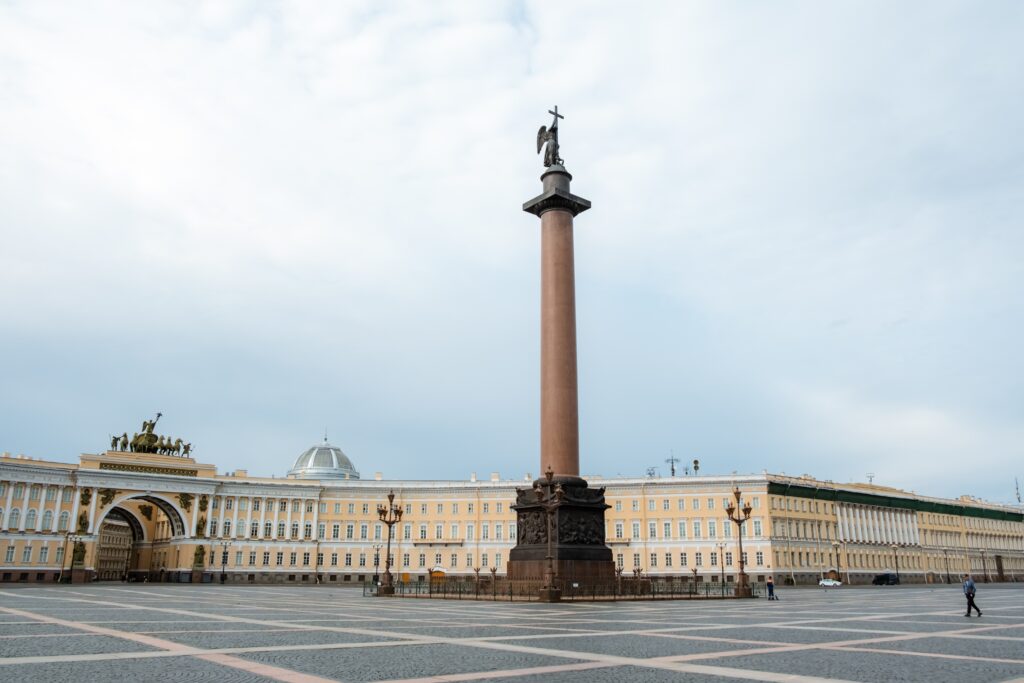
St. Mark’s Basilica
By the 9th century, Venice had become a regional naval and commercial powerhouse, but it was missing spiritual zeal. When two merchants brought the bones of Saint Mark from Egypt to Venice in 828, Venetians discovered what they needed. According to a local legend (probably made up long after the bones arrived), Venice was God’s chosen home for St. Mark: The saint had been blown off course into the Venetian lagoon, where he was visited by an angel who informed him that he would be interred there. The most popular theory: In the medieval age, relics brought a lot of money to pilgrims, and Venetians were eager to capitalize on this opportunity. As a result, the Venetian merchants secreted St. Mark’s bones inside cuts of pork so that Muslim sentries would not rummage through their shipment too thoroughly. St. Mark’s winged lion, which had previously been the symbol of Constantinople, was quickly adopted as the icon of Venice after St. Theodore relinquished his patronage rights.
The present St. Mark’s Basilica was built in the 11th century as a replacement for the original St. Mark’s Basilica, which was accidentally burnt by an enraged mob in the 10th century. The church is one of the most richly ornamented in Europe, with Byzantine influences clearly visible in the domes, sculptural spires, and intricate pointed arches. The brilliant golden mosaics on the façade illustrate the arrival of Saint Mark’s relics into the Venetian lagoon. Inside, look at 4,000 square meters of intricately detailed mosaics. Two pulpits may be found within the basilica: one for the priest and one for doge public announcements.
In 1312, one of these proclamations indicted all Venetians (merchants or crusaders) to seize and return treasures from abroad. St. Mark’s Basilica became a huge robbery cave with an increasing mountain of gold and jewels in the church’s treasury; many of these stolen riches are still on exhibit today. Even the equestrian sculptures in the church’s entranceway (now copies) were lifted from what is now Istanbul.
If you’re bringing a backpack, consult the free bag check on Calle S. Basso, just past and to the left of the basilica’s façade when looking straight down it. Check your luggage here and receive a ticket that allows you to skip the line—a charming win-win situation in a city overflowing with tourist traps.
Free general entry (€2 online reservation), free bag check, €5 to go upstairs to see the horses up close, €3 to go into the treasury (both highly recommended), general entry Mon-Sat 09:45-17:00, Sun 14:00-17:00 (until 16:00 Nov-Easter), St. Mark’s Square, San Marco, group reservations +39 041 241 3817, basilicasanmarco.it

The Campanile
The Campanile, which rises above St. Mark’s Square, is Venice’s most well-known bell tower (and it’s also the city’s tallest structure). Despite the fact that many European great hills do not have elevators, you may ride to the top of this one. Naturally, on clear days, the 91-meter tower provides the city’s best panoramic views—even if they extend as far as the Alps in the distance on occasion. The golden spire and marble belfry were constructed in 1514 originally as a lighthouse to assist mariners navigate through the lagoon. It was rebuilt in time for the tower’s 1,000-year anniversary after a spectacular fall in 1902 (thankfully, no one was injured). Visit as soon as possible to avoid the crowd. (And remember that San Giorgio Maggiore Island, just across the canal, provides a much less crowded panorama—and a photo op that includes the iconic Campanile.)€8, Easter-June and Oct daily 09:00-19:00, July-Sept daily 09:00-21:00, Nov-Easter daily 09:30-15:45, St. Mark’s Square, San Marco

Columns of Venice
Sailing back to England after a long journey must have been a pleasure for mariners. As a result, Venetian merchants became emotionally involved with the Campanile and the two Columns of Venice. The marble columns with Doric caps have a height of more than 40 feet. On the right side, St. Theodore (a Roman soldier who refused to embrace the government-supported pagan religion and Venice’s first patron saint) crowns one column. With his Byzantine heritage, St. Theodore became a liability politically, so Venetians eventually replaced him with St. Mark. On the second pillar is his flying lion (cast in bronze), with one paw resting on a book, proudly displayed.
Free, always open, St. Mark’s Square, San Marco
Doge’s Palace
This mansion-turned-museum is a magnificent illustration of how Venice combined Eastern and Western architecture. In an era when everyone else was hiding out in chilly, dreary castles, the doge and government stayed in this opulent, wonderfully adorned palace and continuously added to it throughout history. The first palace, which was erected in 810 and served as the center of political activity during the city’s golden age, is now a museum. It became a government-run museum in 1923 after being filled with magnificent Renaissance paintings and gilded furniture. While you’re there, go through the governing chambers, royal apartments, magnificent armories, and jail cells where dissidents were imprisoned (including notorious lover Casanova for a time). Keep an eye out for the tiny mailboxes with frightening faces while walking through these enormous rooms. These were places where you could submit letters claiming that someone was guilty of wrongdoing or corruption. Some of the individuals mentioned in these missives may have walked just a few yards from the palace to the prison across the Bridge of Sighs, hence its name, which means “last view” because it was the final glimpse of lovely canals for quite some time, maybe forever. The interior of the bridge, best seen from the next bridge over toward the lagoon, is a popular shot in Venice; you’ll have to push your way to the front of a crowd of photographers during peak season.
The San Marco Square Museum Pass, which covers the Doge’s Palace and Correr Museum, is available (€20). Simply show your pass at the Correr Museum to skip the line at Doge’s Palace.
€20 adults, €18 students, ticket includes entry to Correr Museum, Museo Archeologico Nazionale, and Sale Monumentali della Biblioteca Nazionale Marciana, Apr-Oct daily 08:30-19:00, Nov-Mar daily 08:30-17:30, last entries an hour before closing, closed on Christmas and New Year’s Day, St. Mark’s Square, San Marco, +39 041 271 5911, palazzo-ducale.visitmuve.it
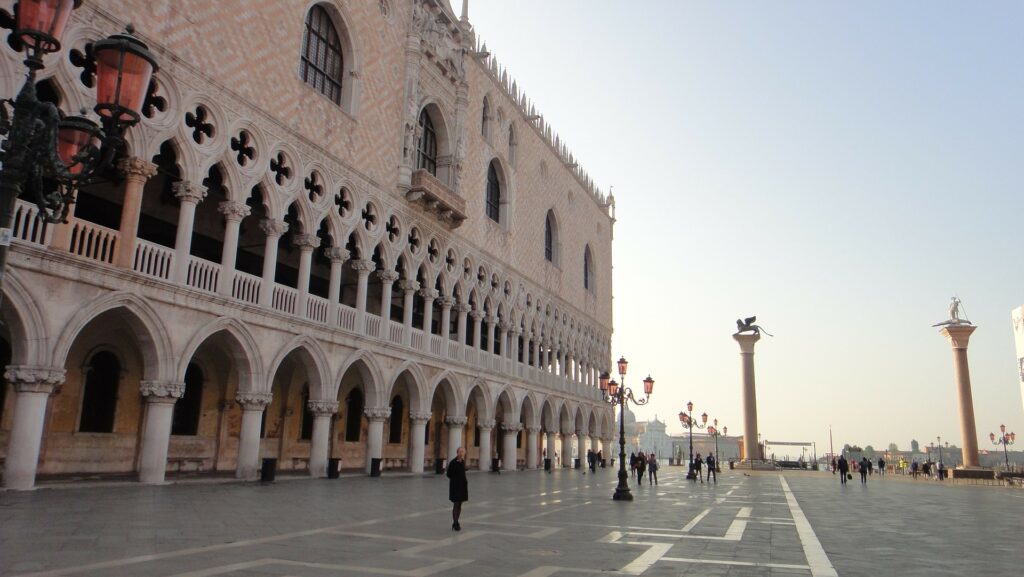
Correr Museum
The Correr Museum, which I’ve always thought to be one of the most fascinating in town, was bequeathed by a wealthy collector in 1836. The art went on show in 1836 and includes paintings, sculptures, and artifacts that together provide a rich image of daily life in Venice from the 15th century onwards. Enter via the colonnade at the far end of St. Mark’s Square and go right up the magnificent staircase. Allow at least 90 minutes for this museum, which runs along St. Mark’s Square from end to end—longer if you’re a big art or history fan.
€20 adults, €18 students, also includes entry to Doge’s Palace, Museo Archeologico Nazionale, and Sale Monumentali della Biblioteca Nazionale Marciana, Apr-Oct daily 10:00-19:00, Nov-Mar 10:00-17:00, last entry one hour before closing, St. Mark’s Square, San Marco, +39 041 240 5211, correr.visitmuve.it

Glassblowing Demonstration at Galleria San Marco
Glassmakers are not permitted on the island of Venice because of the fire risk, but you may watch a professional glassblowing performance at Galleria San Marco. The welcoming team escorts you up the steps and directly into the workshop. An artist picks up a slag of molten glass and puffs their way through a series of pinches, rolling, reheating, kneading, and adding different pieces of glass for color and texture. A glass vase or a little horse sculpture forms in front of your eyes. The artist’s nimble movements are narrated by an English speaker. When your glassblower tosses the completed glass piece back into the oven to quickly melt—ready to be recycled for the next show—your 20-minute demonstration comes to an end. After that, there will be a 15-minute sales pitch from the team, followed by shopping time. (TIP: Make good use of the complimentary restrooms while you’re here; they’re tough to find elsewhere.)
Find the passage between #140 and #141 on the main square and turn left at the T. Show this book and they’ll give you a private demonstration and a 20 percent discount on any purchases.
Free, souvenirs from €15, daily 10:00-17:00, demonstrations running whenever there’s an audience, 181A San Marco (see directions in listing), San Marco, +39 041 271 8671, galleriasanmarco.it
Grand Canal
The Grand Canal is Venice’s jugular. This artificial waterway, which cuts a distinctive z-shaped line through the center of the city’s almost 200 islands, serves as a thoroughfare for all of Venetian life. Everything that goes by on a road floats by here, from taxis to buses to ambulances to private boats and construction boats, as well as grocery delivery services, police and firefighers, and more—all aquatic versions of their land-based counterparts. At least once during your stay in Venice, you’ll need to cross paths with this channel.
Free, always open, crossing points at Ponte degli Scalzi, Ponte Rialto, and Ponte dell’Accademia
Rialto Bridge
The Rialto Bridge (Ponte Rialto) is the magnificent, gleaming-white stone bridge seen in numerous photographs of Venice that entice visitors from all around the globe. It’s certainly one of the world’s most well-known stone bridges. After a century and a half as a pontoon bridge and then a timber bridge, it was rebuilt in stone during the 16th century after several collapses. It was the only permanent bridge over the Grand Canal until the 19th century, when two more bridges were constructed (when it became known as The Bridge of Sighs). Because so much of Venice’s transportation used to flow across this bridge, it’s no surprise that the Rialto neighborhood surrounding it became and remained the city’s social and commercial center. Today, you’ll find a plethora of shops selling touristy knickknacks, timepieces, and jewelry here (don’t anticipate any deals).
Free, always open, Rialto
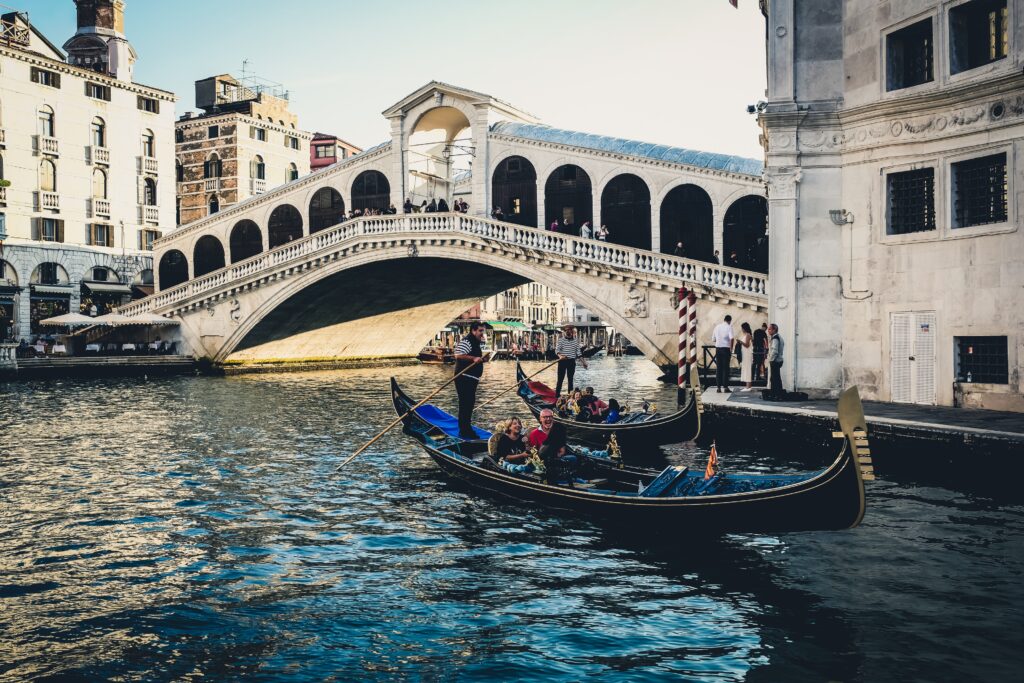
Gallerie dell’Accademia
The Galleria dell’Accademia, which is located in Venice’s most illustrious art museum, the Galleria dell’Accademia, houses a wide range of works from the 14th to 18th centuries. You’ll come across masterpieces by Tintoretto, Titian, Bellini, and Veronese among other greats. Leonardo da Vinci’s Vitruvian Man—the guy in a circle with his arms and legs outstretched that has been plastered on just about everything over time—is one exceptional highlight. It’s probably the greatest artist’s second-most-famous work of art.
€12, free first Sun of the month, Tues-Sun 08:15-19:15 (until 17:00 in winter), Mon 08:15-14:00, last entry 45 minutes before closing, Campo della Carita, Dorsoduro, +39 041 520 0345, gallerieaccademia.org
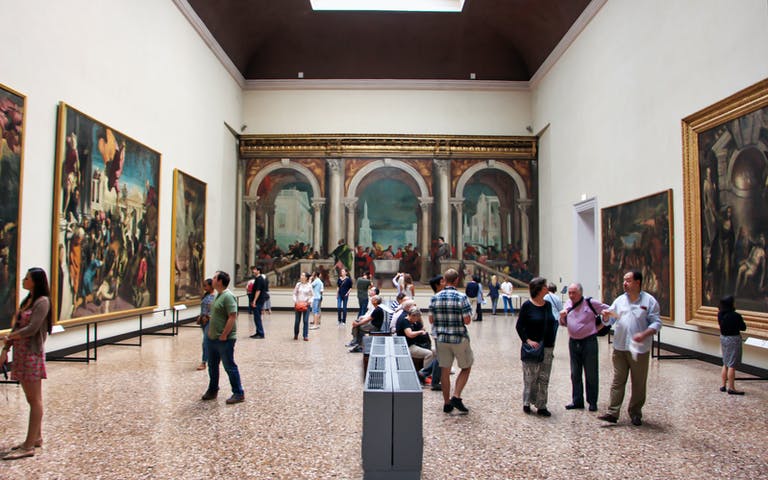
Peggy Guggenheim Venice
This art museum houses one of the world’s greatest modern art collections, with such artists as Picasso, Dalí, and Pollock represented. Futurism, cubism, and surrealism are all represented by well-known names like Picasso and Dalí. Free and informative background discussions are offered often.
€15, Wed-Mon 10:00-18:00, closed Tues, Dorsoduro 701, Dorsoduro, +39 041 240 5411, guggenheim-venice.it
Ca’ Rezzonico
The magnificent palace of a prominent Venetian family, built in baroque style on three lavish stories with big windows and elaborate balconies, is filled with furniture and artwork from Venice’s exuberant 17th and 18th centuries. The beauty of the outside matches the art within, which includes works by Canaletto, Longhi, and Tiepolo from the era.
€10, covered by Venezia Museum Pass, Wed-Mon 10:00-18:00, Nov-March until 17:00, closed Tues, ticket office closes one hour before museum, Fondamenta Rezzonico, Dorsoduro, +39 041 241 0100, carezzonico.visitmuve.it
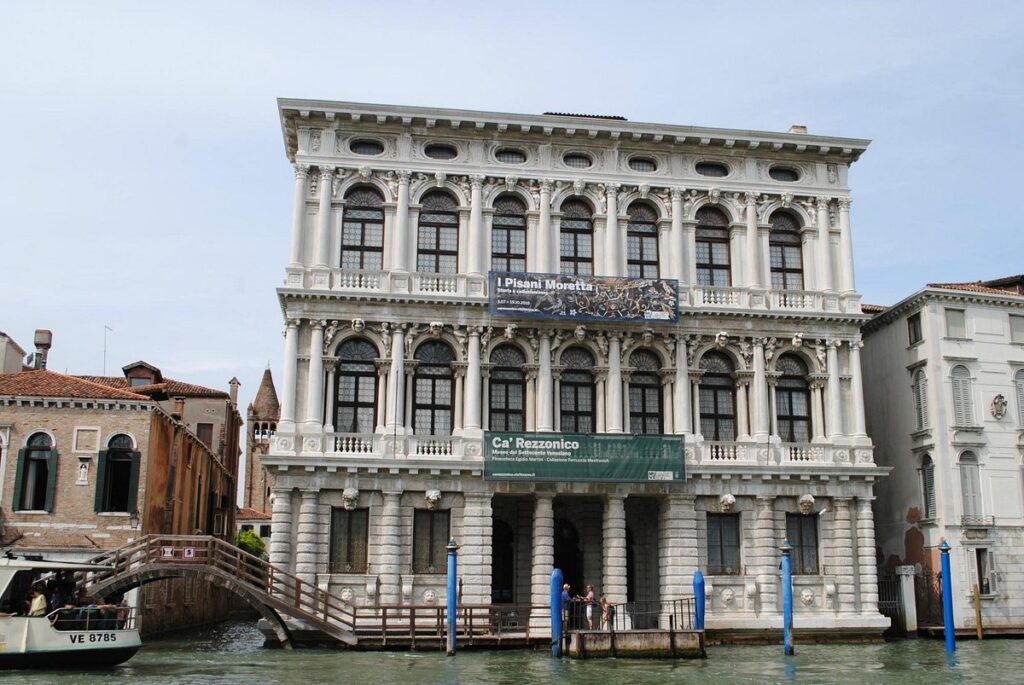
San Giorgio Maggiore Island
San Giorgio Maggiore, immediately across the Grand Canal from St. Mark’s Square, boasts one of Europe’s most famous islands. A short vaporetto hop zips you to this tiny, one-sight island dominated by the grand, gleaming-white San Giorgio church (free, climb bell tower for €6, daily 09:00-19:00, Nov-Mar closes at dusk, +39 041 522 7827). Take the lift to the top for stunning views of the main islands of Venice and the entire lagoon. Note that the lift stops running 30 minutes before the church closes and is not accessible Sundays during services.
Connect to San Giorgio Maggiore aboard vaporetto #2 from a stand on St. Mark’s Square.
Murano Island
This island was a commercial center as far back as the 7th century, but it became the epicentre of an art style intimately linked with Venice in the 13th century: glassblowing. After a number of fires made the dangers apparent, the Venetian Republic banned all glassmaking activities from Venice in 1291. The sector migrated across the water to Murano, where it developed into a significant industry. Artisans were granted considerable advantages owing to their profession: high social standing, immunity, permission to bear swords, and ability to marry daughters into noble families. Glassmakers, on the other hand, were not permitted to leave the country under threat of death since their abilities were so valuable. The dusty Glass Museum (Museo Vetrario, €8, covered by Venezia Museum Pass, daily 10:00-18:00, Nov-Mar until 17:00, Fondamenta Giustinian, +39 041 739 586, museiciviciveneziani.it) is a worthwhile visit to see samples of Venetian glass both ancient and modern. The dated displays take you all the way back to 1,900-year-old Roman glass, and continue through the techniques and artifacts from Venice’s golden age. Time your visit for a live demonstration and tour (Tues and Thurs at 14:30), which provides an in-depth examination of the glassmaking process.
The operational factories are generally closed to the public, but there are a number of opportunities to watch artisans make a basic piece in front of your eyes (invariably followed by a sales pitch). Try Vetreria Artistica Colleoni (tours at 10:00, 11:00, 11:30, 14:00, 15:00, and 15:30 daily, Fondamente Colleoni 7, +39 041 527 4872, colleoni.com, vaporetto: Murano Faro), opposite the Glass Museum (just a 15-minute walk across the canal) for a 20-minute glassblowing demonstration by the team of artisans making custom and retail pieces. Your €10 ticket gives you credit for the same amount in the gift shop, and many of the smaller pieces start around this price point, so you’ll walk away with a nice souvenir.
Otherwise, just follow the Fornace Glass signs—they’ll take you to a workshop. They all tend to close around lunchtime (13:00-15:00), and the best time to visit them is in the morning.
Getting to Murano is easy enough. From the main train station, take the direct vaporetto #3. You’ll be there in about 20 minutes. From San Marco take vaporetto #7.
Burano Island
Burano, known for its lace-making industry, is well worth the visit for some window-shopping. Burano’s pastel-colored homes and peaceful streets offer a tranquil afternoon just minutes away from the city center by vaporetto. On the main square, Piazza Galuppi, you’ll find the small Lace Museum (€5, Apr-Oct daily 10:00-18:00, until 17:00 Nov-Mar, Piazza Galuppi 187, museomerlet-to.visitmuve.it, +39 041 730 034) demonstrating the island’s stock in trade. Loads of items on display take you through more than five centuries of lace making. You can even catch local grannies carrying on the tradition in person—ask politely and they’ll happily show you what they’re working on.
Vaporetto #14 connects San Marco with Burano in about 50 minutes.
San Michele Island
San Michele Island has served as Venice’s cemetery for almost two centuries. With real estate on the main island in short supply (and sanitation a priority), it became necessary to transport the deceased away from populated areas. As a result, San Michele—a whole island of the dead—stands out. It wasn’t always a cemetery, so you’ll also find Chiesa di San Michele, which is Venice’s first Renaissance church.
Hop out here on a quick seven-minute ride. Take vaporetti #4.1 or #4.2 from Fondamente Nova B, on the north side of the main island, just north of Ospedale (Hospital) San Giovanni e Paolo.
Lido Island
Lido is the long and skinny island that separates the Venetian lagoon from the Adriatic Sea. As it’s built on actual land, Lido feels more like a typical town—complete with buses and resorts—than Venice does. Come out here on a hot day to relax on the beaches and get away from the crowds.
Take the rossa (red) vaporetto from the San Marco Giardinetti stop for a fast-moving 12-minute ride across the lagoon. Buses take you up and down the island for €1.50. The best beaches are towards the very south end of the east side of the island.

